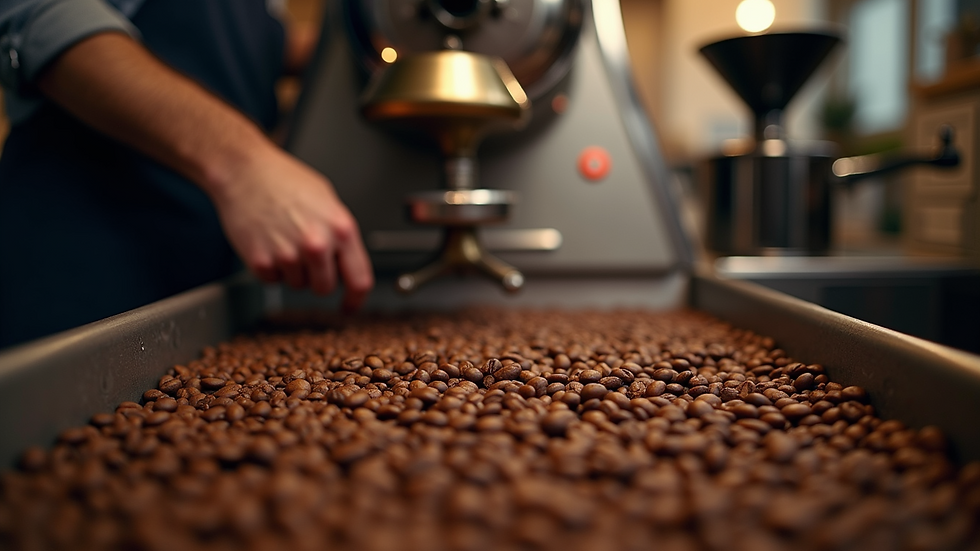Mastering the Art of Specialty Coffee Roasting
- Jul 29
- 4 min read
Coffee roasting is a fascinating craft that transforms green coffee beans into the aromatic, flavorful beverage loved worldwide. Whether you are a home enthusiast or a budding professional, understanding the nuances of coffee roasting techniques can elevate your coffee experience. This guide will walk you through essential concepts, methods, and tips to help you master the art of coffee roasting.
Understanding Coffee Roasting Techniques
Roasting coffee is both an art and a science. The process involves heating green coffee beans to develop their flavor, aroma, and color. Different roasting techniques influence the final taste profile, acidity, body, and aroma of the coffee.
Common Roasting Methods
Drum Roasting
This traditional method uses a rotating drum heated by gas or electric elements. Beans tumble inside the drum, roasting evenly. Drum roasting allows precise control over temperature and time, making it popular among specialty roasters.
Air Roasting
Also known as fluid bed roasting, this method uses hot air to roast beans suspended in a stream of air. It produces a cleaner, brighter cup with more pronounced acidity.
Pan Roasting
A simple, manual method where beans are roasted in a pan over direct heat. It requires constant stirring and attention but is great for small batches and experimentation.
Oven Roasting
Using a conventional oven, beans are roasted on a tray. This method is less precise but accessible for beginners.
Key Variables in Roasting
Temperature: Roasting temperatures typically range from 370°F to 540°F (188°C to 282°C). Higher temperatures speed up roasting but risk burning.
Time: Roasting time varies from 8 to 20 minutes depending on the desired roast level.
Airflow: Proper airflow removes chaff and controls bean temperature.
Cooling: Rapid cooling stops the roasting process and preserves flavor.
Experimenting with these variables helps develop unique flavor profiles.

What is a speciality coffee roaster?
A speciality coffee roaster is a professional or business dedicated to roasting high-quality coffee beans with precision and care. Unlike commercial roasters that focus on mass production, speciality roasters emphasize flavor, origin, and bean quality.
Characteristics of a Speciality Coffee Roaster
Bean Selection: They source premium, often single-origin beans with traceable provenance.
Small Batch Roasting: Roasting in small batches ensures consistency and attention to detail.
Roast Profiling: They develop custom roast profiles tailored to each bean’s unique characteristics.
Quality Control: Rigorous cupping and tasting sessions ensure only the best beans reach customers.
Sustainability: Many speciality roasters prioritize ethical sourcing and environmental responsibility.
Speciality coffee roasters play a crucial role in the coffee supply chain by unlocking the full potential of each coffee bean.

Essential Equipment for Coffee Roasting
To master coffee roasting techniques, having the right equipment is vital. Here are some essentials:
Roaster Machine: Choose based on batch size and method preference (drum, air, or manual).
Green Coffee Beans: Source fresh, high-quality beans from trusted suppliers.
Thermometer and Timer: Monitor temperature and roasting duration precisely.
Cooling Tray or Fan: Quickly cool beans to halt roasting.
Scale: Measure beans accurately for consistent batches.
Storage Containers: Use airtight containers to preserve roasted coffee freshness.
Investing in quality equipment improves control and consistency, which are key to mastering roasting.
Tips for Perfecting Your Roast
Mastering coffee roasting techniques requires practice and attention to detail. Here are actionable tips:
Start with Small Batches: This reduces waste and allows you to experiment with different profiles.
Keep Detailed Logs: Record temperature, time, airflow, and tasting notes for each batch.
Listen for Cracks: The first and second crack are audible cues indicating roast stages.
Adjust Gradually: Make small changes to temperature or time to refine flavor.
Cool Quickly: Use a cooling tray or fan to stop roasting immediately.
Taste Often: Regular cupping helps identify flavor changes and improvements.
By following these tips, you can develop a consistent and delicious roast.

Exploring Flavor Profiles Through Roasting
Roasting transforms the chemical composition of coffee beans, creating a wide range of flavors. Understanding how roast levels affect taste helps you tailor your coffee to your preferences.
Roast Levels and Their Characteristics
Light Roast
Retains most of the bean’s original flavors, often fruity and floral. Higher acidity and lighter body.
Medium Roast
Balanced flavor with moderate acidity and body. Notes of caramel, nuts, and chocolate often emerge.
Dark Roast
Bold, smoky, and bitter flavors dominate. Lower acidity and fuller body.
How to Choose Your Roast Level
Consider the bean origin and natural flavor notes.
Match roast level to brewing method (e.g., espresso often pairs well with medium to dark roasts).
Experiment to find your preferred balance of acidity, sweetness, and bitterness.
Roasting is your tool to unlock the diverse flavors hidden in coffee beans.
Elevate Your Coffee Experience
Mastering coffee roasting techniques opens a world of possibilities. Whether you want to impress friends, start a small business, or simply enjoy better coffee at home, understanding roasting is essential.
For those interested in diving deeper into the craft, exploring specialty coffee roasting resources and communities can provide valuable insights and inspiration.
With patience, practice, and passion, you can transform humble green beans into a cup of coffee that delights the senses every time. Happy roasting!





Comments